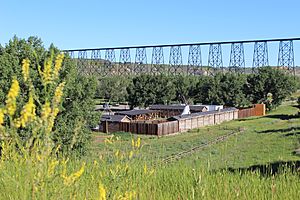Fort Whoop-Up facts for kids
Quick facts for kids Fort Whoop-Up |
|
|---|---|
| Fort Hamilton | |
 |
|
| Etymology | Nickname adopted as official name |
| Location | Alberta, Canada |
| Nearest city | Lethbridge |
| Area | 1.6 km (0.99 mi) |
| Founder | J.J. Healy, A.B. Hamilton |
| Built | 1870 |
| Original use | Fur and Whisky Trading |
| Demolished | 1915 |
| Rebuilt | 1967 |
| Architect | William S. Gladstone |
| Owner | City of Lethbridge |
| Important events | Battle of the Belly River, NWMP March West 1874 |
| Lua error in Module:Location_map at line 420: attempt to index field 'wikibase' (a nil value). | |
Fort Whoop-Up was a famous trading post in Alberta, Canada. It was first called Fort Hamilton. People gave it the nickname "Whoop-Up" because of all the lively activities happening there.
This fort was a busy place for trading in the late 1800s. People traded many things, but some also traded forbidden goods. Back then, there wasn't much law enforcement in the area. This meant some traders sold items that were not allowed. They often charged very high prices for these goods. Today, a replica of Fort Whoop-Up stands in Indian Battle Park. It is an interpretive centre where you can learn about its history.
Contents
The Fort's Early Days
Fort Hamilton was first built in 1869. Two traders from Montana, J.J. Healy and A.B. Hamilton, started it. They wanted a place for trading. Sadly, the first building burned down within a year. No one knows if it was an accident or set on purpose.
A stronger fort was built to replace it. This new fort was nicknamed Fort Whoop-Up. It took two years to build and cost a lot of money. The fort was located where the Belly (Oldman) River and the St. Mary's River meet. This spot was about 6 kilometers south of where the replica stands today.
Trading at Fort Whoop-Up
Many people think Fort Whoop-Up was only for trading forbidden goods. While it was known for this, much more legal trading happened there. Traders exchanged furs for blankets, food, and even firearms. It was a vital hub for many kinds of trade.
The North-West Mounted Police Arrive
The activities at Fort Whoop-Up and nearby areas caused concern. There were also rumors of an American flag flying over Canadian land. These things led to the creation of the North-West Mounted Police (NWMP). This new police force was formed to bring law and order to the Canadian West.
In 1874, the NWMP began their famous "March West." Fort Whoop-Up was one of their main destinations. Their goal was to show that Canada was in charge of the territory.
What the NWMP Found
The NWMP arrived at Fort Whoop-Up in October 1874. They searched the fort for forbidden goods but found none. They also checked the flag that was reported as an American flag. It turned out to be a special trade flag for the fort. This flag was later used by the City of Lethbridge as its municipal flag.
Since the NWMP found no reason to close the fort, they moved further west. Fort Whoop-Up continued its legal trading activities.
Stopping Illegal Trade
The NWMP soon began to crack down on illegal traders. Their first success came after a Native person complained at Fort Macleod about being sold overpriced forbidden goods. The NWMP quickly caught and fined those traders. Even with the police present, some illegal trading still went on.
In 1875, the NWMP rented a room from the fort's owners, Healy and Hamilton. They set up a police post there. This arrangement lasted for at least twelve years. The fort served as both a trading post and a police station.
The fort was sold to Dave Akers the next year. He managed the fort almost until it was no longer used. In 1888, a fire started in the NWMP barracks at the fort. This fire was not as bad as the first one. Only the barracks were destroyed.
Fort Whoop-Up continued to operate until it was left empty between 1890 and 1892. Over time, pieces of the fort were taken away. The last parts were washed away by a flood in 1915.
Why the Name "Whoop-Up"?
There are a few ideas about how Fort Hamilton got its nickname, "Whoop-Up."
- One idea is that it came from the exciting activities at the fort. People would say they were going to Fort Hamilton "to whoop it up!" This meant they were going to have a lively time.
- Another idea comes from how bull trains moved. A "bull whacker" would crack his whip to get the bulls moving. This was called "whooping them up." This might have led to the trail being called the Whoop-Up Trail, and then the fort got the same name.
Rebuilding the Fort
A new version of Fort Whoop-Up was built in 1967. This was a special project for Canada's centennial. It was built downstream from the original site. The new fort was designed to look like the original, based on old photos.
Today, the replica fort has many interesting exhibits. These include:
- The Thunderchief Collection: This shows artifacts from the local Blackfoot culture.
- The Shockley Firearms Gallery: Here you can see different types of old firearms.
- Voice from the Past: This is an audio program that gives guided tours.
In the summer, actors perform re-enactments. They bring to life characters from the fort's history. These shows are done with local groups and talent.
Images for kids


